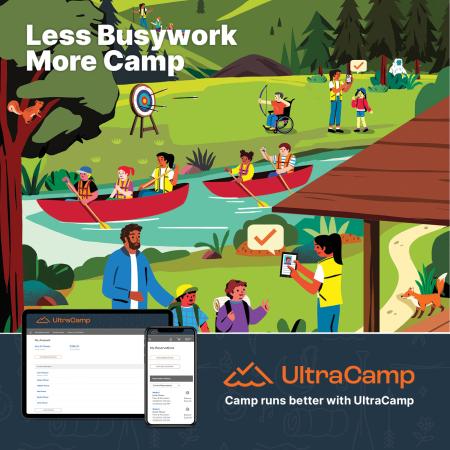As industry and societal expectations push for updated facilities, in-depth programming, equitably paid summer staff, and larger year-round teams to make it all happen, camps face the challenge of paying for it all. Summer-only operations are seemingly less common, and even robust shoulder seasons of youth programming often can’t keep pace with the demands of operating a modern summer camp. Getting the most out of your facilities, operational expertise, and staff talent year-round is essential.
As a small, independent nonprofit camp in Michigan, Camp Newaygo has adapted its business model to include various revenue streams, including weddings and corporate retreats, supported by their on-site catering company. The income from this non-mission-based arm of operation has allowed Camp Newaygo to bring in high-quality staff and expand their facilities — which, in turn, allows them to recruit and retain diverse and lucrative business while improving their core programs. TrueNorth Community Services, the camp’s parent organization, supports Camp Newaygo with technical expertise and resources.
The success of Camp Newaygo’s business model stems from creative leadership that responds to any new idea with “Yes, and . . . ” — a mindset that leaves ideas and conversations open to possibilities. Any camp can adapt the model of “Yes, and . . . ” by staying open to new ideas and the challenges they might bring. Consider the following as a starting point in diversifying your operations and maintaining a full calendar of income-driven opportunities in tandem with your mission-based programs.
Strategies to Diversify Income Streams
Start by dreaming up the possibilities. What is that intriguing idea that keeps popping up in your mind but you’re too afraid to pitch to your team? Have you always wanted to host a weekend fly fishing workshop, or do you know a beautiful spot overlooking the lake that would make the perfect backdrop for a wedding ceremony? This is the exciting part of expanding your facility, staff, volunteers, and vision capabilities. Brainstorm it all. No idea is too radical. When your team is open to the “Yes, and . . . ” approach, every idea can be developed. The key is to have these conversations, celebrate creative ideas, and encourage your team to embrace the process.
Your next challenge is to pick one idea to implement from your brainstorm results. Start with an idea that utilizes your readily available facilities and resources. Just because you don’t have a formal dining hall doesn’t mean that you can’t hold a wedding. People are getting married in barns these days! Try not to get bogged down by where your facility needs to be and instead conceptualize how your current facility already is the backdrop for your latest venture.
Consult with your legal and financial advisors to help you make decisions regarding classification of income, alcohol policies, structuring gratuity, rental agreement contracts, and all other daunting topics. But don’t give up! If a small camp in West Michigan can figure this out, so can you.
Client Recruitment Practices and Branding Concepts to Raise Your Profile
Everyone knows you as canoes, tie dye, and campfires — in other words, a summer camp. How do you shift that mindset without losing your mission and the core programs that keep you in this business?
Like Camp Newaygo, consider keeping your unrelated business separate from your mission-based program. You don’t want people to forget that first and foremost you are a summer camp providing a safe place for children to grow into their best selves. However, in striving to provide a beautiful venue for other uses — such as space for two people to create a wonderful matrimonial memory — you can leverage your mission to draw in clients to your other business. In doing so you may open the door for them to develop a connection with the heart of what you do. In turn, you may see some positive feedback.
For example, Camp Newaygo shares its core mission when marketing the camp as a wedding venue, and prospective clients understand that their business will support something greater. A recent wedding couple had this to say:
Just had our dream wedding at camp and cannot thank staff enough for saying yes to every idea we had along the way. Truly made the experience special. All the staff were great, super accommodating, and friendly. We are forever fans of the amazing work being done at Camp Newaygo and happy to support their mission. Thanks again!!!
-CN Happy Couple
In a post-pandemic world, rental groups and businesses are craving human connection. Your summer camp facility and staff can be a perfect fit for paying customers — you just have to find them.
The Camp Newaygo revenue stream has been diversified through existing networks like Airbnb, WeddingWire/The Knot, and paid Facebook/Instagram advertising. Camp Newaygo has partnered with the local hospital to provide monthly housing for traveling nurses and interns. By providing staff paid time to serve on local boards, Camp Newaygo has secured event rentals from, among others:
- United Way
- Rotary
- Local trail associations
- Women in business events
- Local museums/arts venues
Having a year-round presence within our local community has led to micro fundraisers, including bake sales, and recruitment of sponsorships for events. Leveraging Camp Newaygo’s mission as an asset in client sales shifts the renter’s mindset away from a charity to a choice. As Millennials’ and Gen Zers’ spending power increases over the next 10 years, both generations will seek to use their purchasing power to effect positive change. Camp Newaygo’s catering business, Ridge Catering, uses the tagline “catering for a cause.” Marketing your mission will increase sales, set your venue apart from other competitors, and lead to greater client reengagement post event.
Practices from Other Food Service and Hospitality Industries
Incorporating practices from other food service and hospitality industries can elevate your business and income sources for a higher facility and staff level. For profit margins, even with the rising costs of inflation, in-house food service can be a lucrative way to expand your business model. So how do you start to add food service to your facility, especially if your kitchen team is only seasonal? Use all of your resources. When Camp Newaygo started to expand its revenue stream over a decade ago, we relied on outside catering, volunteers, and minimal year-round staff. Camp Newaygo currently employs a full-time events director, chef, and sous chef, in a similar structure to other non-summer-camp industries. This culinary team implements the summer food service, alongside year-round on- and off-site catering services. The structure of this staff has allowed Camp Newaygo to increase its local community mission-based service, with specialty dinners and holiday events.
Camp Newaygo added an executive chef position as a fourth year-round staff member instead of hiring in youth programs. We sourced candidates from a local network outside the summer camp industry and recruited with the allure of non-restaurant hours, optional housing, and quality health insurance.
Even at a camp that has expanded its revenue streams for more than 10 years, we still rely heavily on volunteers for events and retreats. Utilize the network you have. Reach out to supporters, volunteers, and board members who already support you, and plan for a systematic, staged approach to growth.
Customer Service Tips to Maximize Client Referrals and Reviews
Yes, your dining hall is better than a barn, but there are still benches with kid graffiti and plastic six-ounce cups that adults might find a little tedious to refill. Now is the time for a shift in customer service tactics. You’ve mastered the art of making camp the best place in the world for that eight-year-old camper. How do you transform it into the most memorable place for a couple about to say, “I do”? You listen to their needs. Is their wish list possible? Are you able to say “Yes, and . . . ” to their vision? If they are considering your venue, then chances are they love the idea of rustic benches. And their budget might allow for an upcharge to get large, adult-sized water glasses.
Your organization’s ultimate goal is to expand your mission of service. By sending out anniversary cards to wedding couples and including a copy of your family camp brochure, you are reminding them that camp can be a permanent fixture in their family’s recreational future. Camp Newaygo requests that renters allow camp program brochures to be present at events, and many guests request a stop at the camp store, proudly displaying Camp Newaygo merchandise as an event memento.
For our summer campers, the camp experience is transformative. By taking advantage of the training you already provide to your staff team and the intentionality of your site plan, customer service skills can easily shift from a camper population to a rental group. Trust in your team’s existing commitment and skill level to produce events that are fun — even if they aren’t perfect yet.
Giving New Revenue Streams Staying Power
We’ve framed these initiatives as non-mission-based components of a camp’s operation, but, ultimately, you need to be able to connect everything back to the core of what you do — for your stakeholders, your participants, and your team. Practically, corporate retreats would create income to support your core camp programs, but that retreat still happens at your site, with your staff, under your camp’s brand. Consider the subtle yet intentional ways having a wedding at your camp can be uniquely your brand and connect to your camp experience. Does your preconference communication reflect the clarity and efficiency of your precamp communication? Do your standards for greeting camp families on arrival day inform how warmly your staff welcomes guests to a wedding reception? How do your new clients perceive and experience your organization’s values? Using your core camp programs as your “source material” for new initiatives will ensure that saying yes provides both fiscal and mission sustainability.
Photos courtesy of Camp Newaygo, Newaygo, MI.
Jalisa Danhof has wanted to be a camp director since fifth grade and is now in her 13th year as director at Camp Newaygo and still hooked on camping. She has served as the ACA National Emerging Professionals In Camping Chair since 2011. She is a contributor to the GoCampPro podcast, and since her arrival at Camp Newaygo, camp program attendance has increased by 140 percent. Jalisa is a feminist, a mom, a fan of all things chocolate, and a wildly enthusiastic speaker.
Caitlin Voyt has been with Camp Newaygo for over 15 summers. As the business, community engagement and alumni relations director, you can find her on a soapbox all over Michigan promoting the great things you can do at Camp Newaygo. With a master’s degree in history and a previous career with the National Park Service, Caitlin prides herself on maintaining excellent customer service while also preserving and interpreting the magic of camp. Caitlin is passionate about sustainability in camping, is an avid fan of The Office, and is a big fan of Whitney’s Eggs Benedict.
Whitney Sparks started with Camp Newaygo as the executive chef in 2018. She took on the role of catering and events director in 2021. Previous to camping, Whitney spent 10 years working in restaurants after becoming a certified culinarian from the Culinary Institute of Michigan. Whitney enjoys being an active board member of the local tech center’s culinary programs, traveling with her family, and working with couples to give them their best camp wedding experience.
Scott Lakin started at Camp Newaygo in 2017 and has worked in a variety of youth-development settings, including mentoring, afterschool, and community programs. With a background in youth participatory design and community development, he loves solving complex problems in order to support fantastic experiences for campers, staff, and volunteers as the director of programs at Camp Newaygo. Scott is passionate about supporting diversity, equity, and inclusion efforts in camping, is a decent underwater basket weaver, and uses pirate ships as inspiration for home decor.


